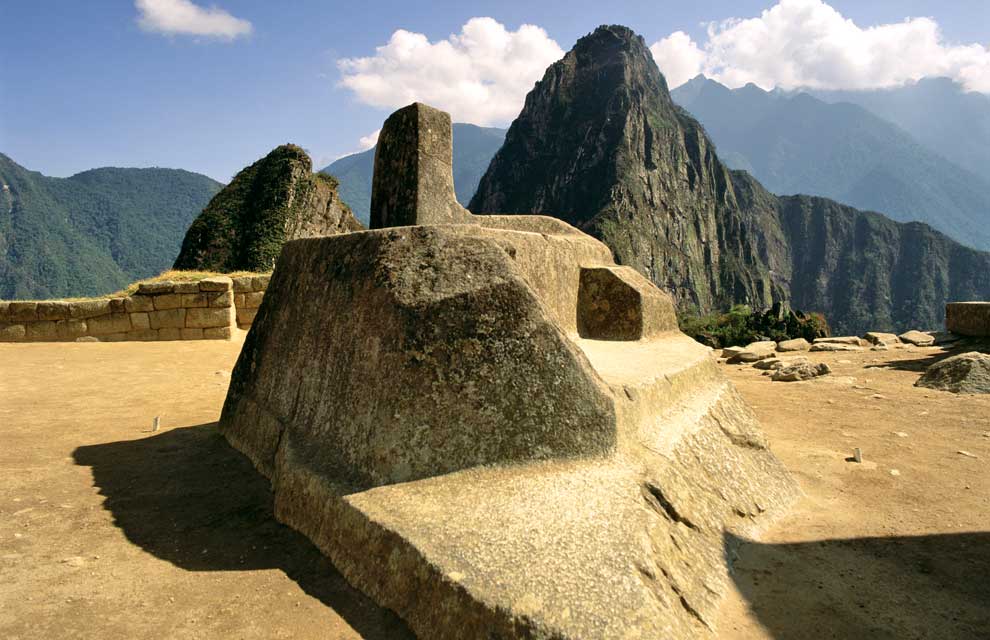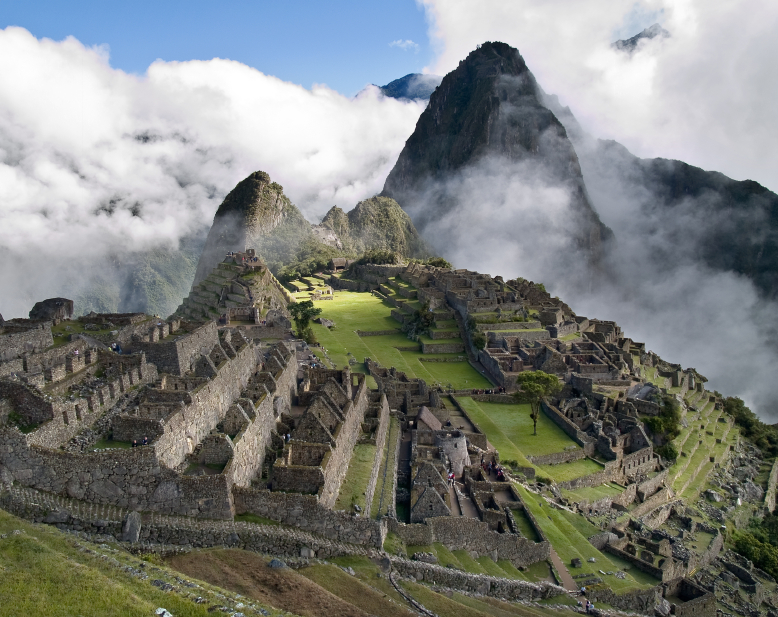I finally made it. And it was completely worth it.
We couldn't have timed this trip better. Jackie, a friend from high school, had some free time to travel in Latin America this summer and we both were itching to see Machu Picchu. It was a stunning day with plenty of sunshine, and none of those pesky low-hanging clouds. Not only did we go to Machu Picchu ON the winter solstice (which is pretty great for a site built around the sun's movements), but -- in a stroke of luck -- we also got to stick around Cusco for the Inti Raymi festival. I'll follow up with other posts about our exploration of the city and Sacred Valley, and just focus on Machu Picchu for now. As you'd expect, I have a lot of pictures to share.
We had some doubt we were going to make it. There was a landslide on the train tracks between Ollantaytambo (where we were staying in the Sacred Valley) and Aguascalientes (the town right below Machu Picchu). The whole day before the entire track was shut down, and we were a bit worried that we would have to take a 10 hour bus ride around the valley instead of a 90 minute train ride through it.
But they managed to fix the tracks, and by 4:45 the next morning, we were rolling out of bed for our 6am train.
 |
| Ollantaytambo train station @ 5:30am |
The train trip was really stunning, as we followed the valley to Aguascalientes. There are a number of glaciers in the valley, as that's what originally cut the steep-sided peaks that are ubiquitous. The closer we get to Aguas Calientes, the more tropical it gets. As we follow the river, we start to see more and more bromeliads, orchids, and lilies. This change in climate means we are getting close!
Note: Macchu Picchu is actually at a lower elevation than Ollantaytambo. Cusco sits at 11,000 ft above sea level, and Ollantaytambo is a bit lower at 9,100 ft. Whereas Aguas Calientes is only at 6,700 ft, and Machu Picchu sits atop a ridge above AC at 7,900 ft.
AC is a cute enough town, sitting in lush green surroundings. It has some hot springs, but most people are really only there to see Machu Picchu.
 |
| Statue of Pachacutec in the middle of the town square. |
After a short bus ride up the mountain, we are standing at the entrance by 8:30. Even the first glimpse you catch of the site as you follow the path from the entrance is stunning.
As a bit of history, Machu Picchu was built around 1450 and survived as a city for a little over 100 years before it was abandoned in 1572. Most of the city’s inhabitants are thought to have died of smallpox. The most important thing about the site, though, was that there is no evidence that the Spanish ever visited it in their conquest. Sacred rocks that were defaced by the Spanish in other sites remain untouched at Machu Picchu.
The setting of Machu Picchu suggests it was a sacred site primarily for ceremonial purposes. Not only does the stonework match that found at other religious sites, but also the top of Machupicchu Mountain (which the site is named after) has a platform built by the Inca and was most likely used for various ceremonies.
The site was mostly unknown to non-locals until 1911 when Hiram Bingham, a Yale lecturer who had worked in the region for years was brought to the site by an 11-year-old Quechua boy named Pablito Alvarez. He found some locals even living in the original buildings.
Bingham started excavations shortly thereafter, and the site shortly thereafter received a lot of publicity due to a spread in National Geographic in 1913. However, once accusations started to surface that Bingham was smuggling out artifacts through Bolivia, locals began to oppose the excavation being led by a foreigner. By the time Bingham left in 1915, local intellectuals and landowners had begun to organize and claim their ownership of the site and the objects found there (a fitting end for a site that was spared imperial conquest in the 16th century as well).
 |
| Hiram Bingham memorial plaque |
We decided to hike up to the Sun Gate while it was early and still relatively cool. There were originally two entrances to the site when the Incas lived in it. One was the Sun Gate (Intipunku) from the east, and the other was the Inca Bridge from the west. Both were easy to defend in the case of invasion. The Sun Gate also serves as the entrance for those who arrive at Machu Picchu on the Inca Trail.
 |
| Intipunku from Machu Picchu (it's the low point of the ridge at the top) |
 |
| Some ruins on the hike to Intipunku |
 |
| Machu Picchu from Intipunku (the mountain behind it is Huaynapicchu) |
 |
| A glimpse into the valley beyond Intipunku. |
By the time we got back from Intipunku, we had to start the hike up Machupicchu Mountain.
 |
| Machupicchu Mountain over the terraces (the end of the hike is the pointy tip at the top there) |
There are two mountains that sit on either site of Macchu Picchu. The most popular is Huaynapicchu, as it has a temple on the way and one at the top. It is a longer trail but not as steep. Machupicchu Mountain maybe be shorter at only 1.2 miles in length, but it is almost vertical. You go up about 2,100 ft in that time, almost entirely on steep stairs cut into the mountain.
The Incas loved stairs. Like the rest of the stone stairs throughout the site, the stone stairs that climbed the mountain were build by the Incas. I had to avoid looking over the edge of the stairs, but I managed to keep my fear of heights in check by concentrating on the ground. A grueling hour and a half later, I finally made it to the top.
And, as my fellow hikers would say, "Vale la pena. Es bellisima."
The view from the narrow ridge at the top provided you not only with a stunning view of the site, but you could also see the entire valley around you.
 |
| Bromeliads! (And a view of the Urubamba river valley. Aguas Calientes is up the river to the right.) |
By the time I got back down to meet Jackie by the entrance, it was already early afternoon, and it was time to start exploring Machu Picchu proper.
The city is divided into an agricultural and urban sector. The urban sector is further divided into an upper and lower city. The upper city housed the temples and upper class housing. The lower city held the warehouses and housed the 'commoners'.
 |
| The agricultural terraces in the agriculture sector. |
After passing through the agricultural sector, we began to explore the upper city.
 |
| Yup, I'm pretty gross after my hike. |
 |
| One of the coolest features is the aquaducts that were built into the stonework. These brought in fresh water from surrounding streams for the city’s population. |
The noble houses sat at the top, along with the most important temple. The general rule was the higher up you were, the more important you were.
Here is one of the most important temples in the city: the Temple of the Sun. If we had been there at sunrise, we would have seen sunlight shoot through the temple's windows to light up the room (which is supposed to only happen on the winter solstice).
 |
| The semicircle and the rectangular structure to the right of it make up the Temple of the Sun |
We walked through all of the upper city, exploring its nooks and crannies:
 |
| Hi, Jackie! |
 |
| Chinchillas just chinchillin' in stonework. Yeah, I made that joke while I was at Machu Picchu. |
Then we started to make our way up to the Temple of the Three Windows, by the Intihuatana. The Intihuatana is a ceremonial stone that was meant to "tie to the sun", and the Incas thought this stone kept the sun tethered in the sky. On the winter (and summer) solstice (again, the DAY we decided to go), the shadow this casts is at its longest. On the spring and autumn equinox, there is not shadow at all. So the rock also served as an astronomical calendar.
From the Temple by the Intihuatana, you could see the main residential area of the site.
And Huaynapicchu overlooking it all.
Not only were there chinchillas, but a number of llamas wandering the grounds, serving as natural lawnmowers. Because they are domesticated, you could pet them without repercussions.
 |
| He was less than interested in the grass I was offering him. |
 |
| Warrior pose seemed appropriate at the site of such a fearsome people. |
 |
| Part of the site was restored and part was still under excavation and restoration. Supposedly you can tell the difference by the type of molding in between the stones, but another dead giveaway is the use of wood in any of the constructions. |
 |
| The Inca-style stonework was just incredible. You can see how tightly the stones fit together. These stones were brought in from all over the area for use in construction. I couldn't find it, but there is one wall that has a stone that fits so well, it touches 13 other stones. |
 |
| Just excuse me while I take a nap in this 600 year old house. |
 |
| As you look down, you can see the agricultural terraces below the city as well. Because the terraces covered so many microclimates, some scholars think that it acted as an experimental agriculture station. There are not enough terraces for it to produce food on a large scale, and the terraces are dispersed, covering lots of different altitudes and orientations. |
 |
| The site is also still being restored, so you sometimes find yourselves at the bottom of a staircase like this, where it just...ends. |
 |
| One of the mid-level temples was the Temple of the Condor. |
 |
| I found a cave in the temple, but I was promptly scolded by a guard when I tried to poke my head into it. This pose, however, was sanctioned with a thumbs up. The guards are notoriously dilligent and I'm glad my Spanish was good enough to know what they were yelling at me, unlike many of the other international tourists. |
 |
| The llamas were quite popular, especially when a little white baby llama was involved... |
 |
| More baby llamas! |
 |
| A final shot as we leave for the day. |
We managed to hop a train back to Ollantaytambo while it was still daylight to see the snow-capped mountains and some nearby ruins as we returned to the Sacred Valley.
This near perfect day was capped off with my first traditional Pisco Sour of the trip:
I'd say all-in-all, a huge success.
(If you want to see higher-quality photos, as well as tons of pictures I didn't post, you can access the album here.)

































































